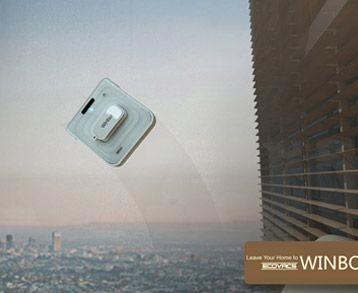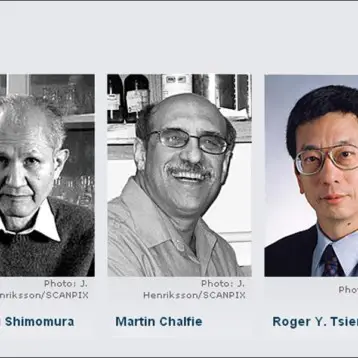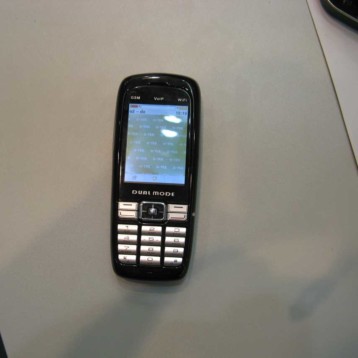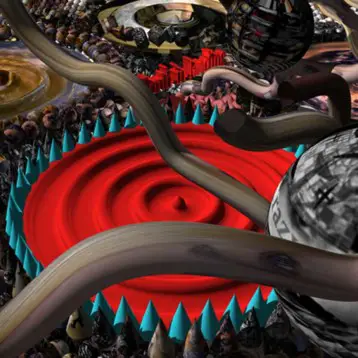|
The mechanical analog machines were designed to solve linear equations, to calculate integrals or roots of polynomials, to serve as harmonic analyzers and more.
The Differential Analyzer was presented by Vannevar Bush in 1931. It was the apex of analog computation, a general purpose analog machine. The core of the machine was based on an old and simple apparatus for integral computation, re-invented by Maxwell, and then re-invented once again by Lord Kelvin in 1876. Vannevar Bush used Kelvin’s version of the machine, depicted in the following illustration.
|
In the picture on the left we see a rotating disc and a small wheel, which is sliding and rotating above the disc. The angular velocity of the wheel depends on the angular velocity of the disc and on the distance ‘p’, which is the distance between the center of the disc and the point where the disc touches the wheel. If the distance ‘p’ is changed as a function of time, p =p(t), then the angle of the wheel at a given moment represents the integral of p(t). The wheel’s angle can be transferred further into a cylinder on which we can easily read the results. To operate the integrator one manually slides the wheel over the disc at a specific rate which corresponds to the function ‘p’. But how does this work?
|
Suppose the disc is rotating with a constant angular velocity, w. At the place where the wheel is standing the velocity of the disc is w*p. Think of a carousel, the further you sit from the center, the bigger your velocity is. Therefore, in the small interval of time ‘dt’, the disc has gone through the arc w*p dt. This is the arc transferred to the wheel in that interval of time. We assume that the distance ‘p’ does not change within this time. If we were to repeat the same computation over and over again, setting a different value of ‘p’ every time, we would find that the arc accumulated by the wheel is close to the integral we are interested in calculating.
Old schemes of analog computers used the following diagram to describe an integrator:
|
|
Note that each integrator unit had three connections, the ‘t’ connection drives the disc, the ‘x’ connection is the output angle from the wheel, and the ‘dx/dt’ connection is the arm that slides the wheel on top of the disc and fixes the wheel at a distance ‘p’ from the center. Usually, we think of the arm-connection as the input and the wheel connection as the output. The relation between the arm connection and the wheel connection is best described as integration.
Kelvin was trying to use the integrator to solve differential equations. For that he had to show that the output of one such unit of integration could be made to be an input for the next unit. For example, to solve an equation with the second derivative you need to double integrate. But the machine was too weak for to carry out these calculations. The wheel could not transfer the angular force, the torque, to the next disc. Vannevar Bush solved this problem by introducing a torque amplifier between each pair of units.
|
The picture above illustrates the torque amplifier. It is amazing in its simplicity and primitivity. The two drums are driven in opposite directions by an outside engine. Suppose one turns the input shaft a little bit clockwise, the input arm would move in the same direction, releasing the cord closer to the input shaft and tightening the other cord. Follow the cords to understand how it works. When the other cord is tightened the output arm moves clockwise with a strong force. The output shaft moves with the output arm. Finally, the result is that the input shaft’s movement is amplified in the same direction. A very similar apparatus was used in small boats.
|
By 1931 Bush had completed the development of his Differential Analyzer. His machine occupied a full room and had several integration units, adders, multipliers, and input and output devices in the form of boards. The machine could solve ordinary differential equations up to the sixth order.
Next, we will look into some details of Bush’s Differential Analyzer. Before solving a certain differential equation it would be necessary to prepare the machine for the computation. It is important to note that in such analog computers one was always required to re-connect all the ‘wires’ before each computation. Once the machine was re-designed according to the differential equation, there was no general program or software to do the job. Re-wiring was also used in the first digital computers before operating system programs were developed. See the following example the image on the right.
|
The computer is designed to solve a known differential equation (gravitational field equation with resistance, like in the case of a parachute). How do you do it?
|
Well, you force a relation between the output of one integrator and the input of the second one. In the above example we have two integrators – I and II, one input device (at the top), and one output device (at the bottom). All are connected by what Bush called ‘buses’. These are long rotating axles, which can be likened to wires between adjacent components. The connections of the first integrator are easy to understand, so we will follow the connections of the second integrator. The arm-connection of the first integrator, ‘dx/dt’, is multiplied by the factor ‘k’, and then summed up to ‘g’ (summation and multiplications are easy to achieve using wheels). The ‘bus’ noted by ‘k(dx/dt)+g’, which is the result of the first step of the computation, is introduced back to the arm connection of the second integrator. Note that the wheel connection of that integrator is ‘dx/dt’. Now the forced relation between the wheel connection and arm connection of the second integrator is exactly the equation that we need to solve. Clearly, ‘x’ is forced to satisfy the relations of our equation. All we have to do now is to start rotating the time shaft, ‘t’. One can then express the value of ‘x’ as a function of ‘t’ on the output board. The function ‘x(t)’ is the solution to our equation.
|
Bush’s machine was quiet a success. You can see it is powerful, simple, and works quickly. It operates in ‘real time’, and does not require a program to translate high language to machine language. In fact, the differential analyzer was used in World War II for computations of missile trajectories. In 1945, Bush and Caldwell presented a new version of the computer, in which an electronic device replaced the mechanical torque amplifier. By that time, electronic analog computers had replaced most mechanical computers. Soon after, the digital computer reappeared, along with the realization that discretization of variables is the right way to solve differential equations. The differential analyzers soon disappeared completely, and can now be found only in museums or in private collections.
V.Bush, Instrumental Analysis, Bull. Amer. Math. Soc. Volume 42, Number 10 (1936), 649-669.
W.W.Soroka, Analog Methods in Computation and Simulations, McGraw Hill, 1954.
W.W.Thomson, On an Integrating Machine Having a New Kinematic Principle, Proceedings of the royal society of London, Feb. 1876.
About the author: Boaz Tamir holds a Ph.D. degree in Mathematics from the Weizmann Institute of Science. In 2008 he recived a second Ph.D. from the department of History and Philosophy of Science at the Bar Ilan University.















